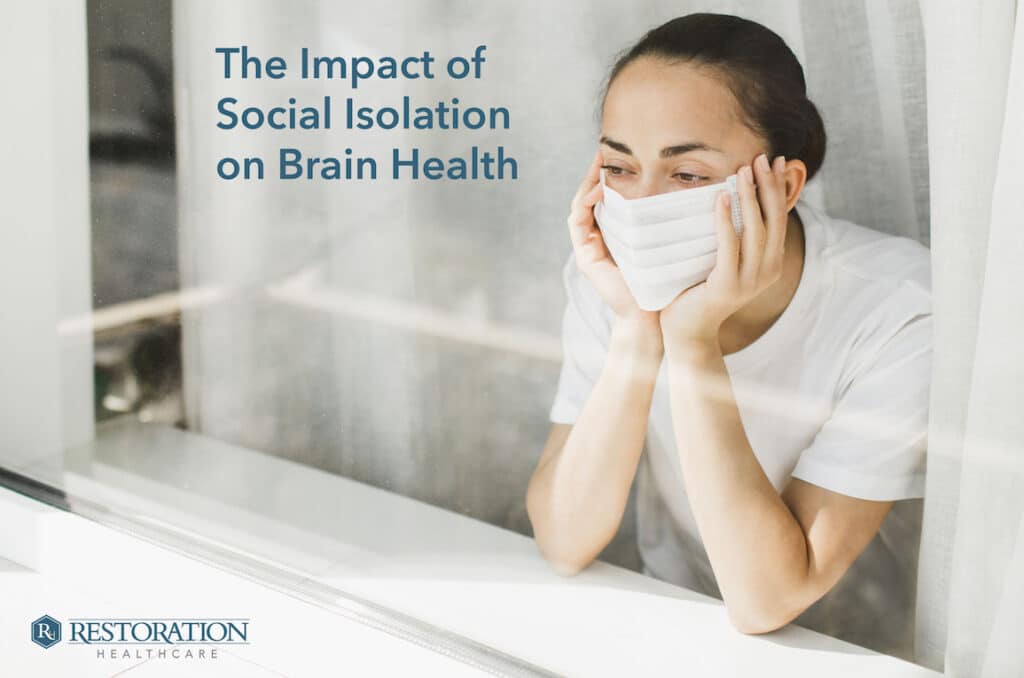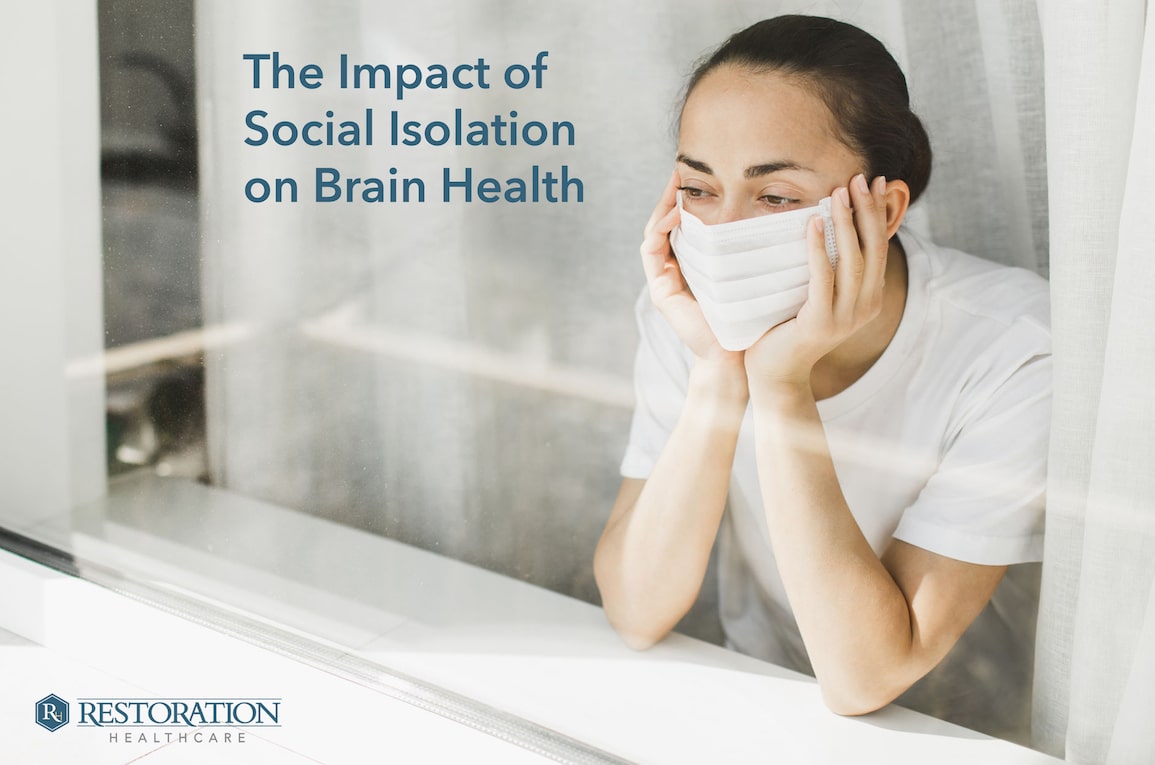The Impact of Social Isolation on Brain Health

Dr. Sanjay Gupta recently told the AARP a story of a 93-year-old man who was brought into the Grady Memorial Hospital emergency room in Atlanta where Gupta was on call. The patient had experienced a head injury resulting in a brain bleed after he had fallen from his roof while blowing leaves. The patient appeared to be suffering from severe neurological decline, but his 94-year-old-wife and 63-year-old son assured Dr. Gupta that before the accident, the man was physically fit and mentally sharp.
Dr. Gupta, a board-certified neurological surgeon, performed surgery to “remove the blood pool and coagulated small remaining bleeders” from the man’s brain, and within hours his mental acuity was restored. During the surgery, Dr. Gupta could tell that the man had a 93-year-old brain, but it was functioning more like the brain of a 50-year-old.
What was this man’s secret to health and fitness? No doubt he had good genes, but he was also an avid runner, continued to work part time as an accountant, maintained his property, had strong and active family and community ties, and even did some volunteer work in western Africa. He remained physically, socially, and mentally active; had a positive outlook; and he lived life with a purpose.
Researchers are discovering more and more evidence supporting what most of us already know — people who are optimistic, engage with others, remain active, and have a sense of purpose live longer and healthier lives. In other words, to a large degree, you are as healthy and fit as you think and act.
Good Health Starts in the Brain
We physicians often think of the brain as being a key to good health, based on the fact that it unconsciously controls so many vital processes in the human body — heartbeat, breathing, digestion, reflexes, and so on. But the brain is also a key to good health in terms of attitude — what you choose to think about, how you think about it, the mental activities you engage in, your relationships with others, and how you choose to spend your life.
Those who have a positive outlook on life, are physically and mentally active, have healthy relationships, and live with a sense of purpose, are generally healthier than those who are pessimistic, detached, and have little or no sense of purpose in their lives.
It is common to say that people who suffer depression or anxiety have a problem with “brain chemistry,” or have a “chemical imbalance.” But people often fail to realize that the brain directs the body to produce those chemicals. Changing the way we think, what we choose to think about, and how we choose to live our lives, has a tremendous impact not only on brain chemistry but also on brain biology and physiology.
We have the power to make our brains healthier by taking more control of our thoughts and emotions. We alone have the power to control our thoughts and our perceptions of what we experience in life. We can choose how we think about and respond to our external conditions, and, to a great extent, our minds give us the power to change our external conditions through choice and innovation.
Focusing on Social Isolation
During the recent and ongoing COVID-19 pandemic, social isolation (or, more precisely, loneliness) has attracted more attention than ever before as a threat to our physical health. In fact, how connected or isolated we feel can have a positive or negative impact on several chemical compounds that can increase or decrease our risks for developing some serious chronic health conditions.
These chemical compounds include the following:
- Nuclear factor kappa-light-chain-enhancer of activated B cells (NF-kB) is a pro-inflammatory compound. Social connectedness tends to decrease NF-kB, whereas social isolation increases it.
- C-reactive protein (CRP), produced by the liver, rises when the body experiences inflammation. Social connectedness tends to decrease CRP, whereas social isolation increases it.
- Interleukin 6 (IL-6) acts as both a pro-inflammatory and an anti-inflammatory. Social connectedness tends to decrease IL-6, whereas social isolation increases it. Increased levels of IL-6 are associated with several chronic illnesses, including:
- Type 2 diabetes
- Cancer
- Heart disease
- Alzheimer’s
- Hormone imbalances
- Osteoporosis
- Some autoimmune conditions, including Crohn’s disease and rheumatoid arthritis
- Myocytes are white blood cells that fight infection. They are generally decreased in people who are socially connected and increased in people who are socially isolated.
- Interferon is released by cells infected with viruses to signal nearby cells to heighten their antiviral defenses. It is generally increased in people who are socially connected and decreased in those who are socially isolated.
- Immunoglobulin G (IgG) is the most common antibody that protects against bacterial and viral infections. It is generally increased in people who are socially connected and decreased in those who are socially isolated.
Here at Restoration Healthcare, a Southern California functional medicine practice, we believe changes in chemistry due to social isolation make the body more susceptible to infection from communicable diseases while creating an inflammatory pattern associated with cardiovascular disease, cancer, type 2 diabetes, and certain autoimmune conditions, including rheumatoid arthritis. In addition, loneliness increases susceptibility to depressive symptoms, impaired sleep, reduced physical activity, impaired cognition, and cognitive decline. On the other hand, chemical changes in the other direction due to increased social connectedness can help to optimize the immune response and keep inflammation at bay.
Note that social isolation alone is not the problem — loneliness is. Living a solitary life doesn’t necessarily make a person feel lonely, nor does having an active social life necessarily prevent a person from feeling lonely. In the context of health and fitness, the state of mind is what’s important.
Reducing the Negative Impact of Social Isolation
If you are feeling socially isolated, realize that your mind is the solution and has the solutions to reduce social isolation and loneliness. Here are a few suggestions to get you started in the right direction:
- Discover or create a purpose. Living with a sense of purpose is like an antidote to social isolation and loneliness. If you’re working with others toward a common objective or goal, it decreases your social isolation. But even if you prefer flying solo, your sense of purpose and the activities you engage in to fulfill that purpose keep your mind off your social isolation, which results in a healthier mindset.
- Increase your social engagement. Physical distancing of a social nature may make social connectedness more challenging, but it does not prevent you from connecting with others. Look for other ways to engage with friends, family members, coworkers, and neighbors to feel more connected (and less lonely).
- Engage in cognitive behavioral stress management (CBSM). Various forms of cognitive behavioral therapy (CBT) help to eliminate counterproductive thought patterns and replace them with healthier, more productive patterns. In one 2011 study, researchers found that “In early-stage breast cancer patients, a 10-week CBSM intervention can reverse anxiety-related upregulation of pro-inflammatory gene expression in circulating leukocytes.”
- Practice mindfulness meditation. An eight-week Mindfulness-Based Stress Reduction (MBSR) program was shown in one study to reduce loneliness, downregulate loneliness-related pro-inflammatory gene expression in older adults, downregulate NF-kB-related gene expression in circulating leukocytes, and reduce C-reactive protein.
- Practice yogic meditation. In one study, participants who practiced Kirtan Kriya Meditation (KKM) for 12 minutes daily for eight weeks experienced a reduction in NF-kB signaling and an increase in IRF1 (IRF1 is short for interferon regulatory factor, which is responsible for coordinating the expression of multiple inflammatory genes.)
- Practice yoga. Breast cancer survivors with persistent cancer-related fatigue who engaged in a 12-week Iyengar yoga intervention showed reduced activity of the pro-inflammatory NF-kB, increased anti-inflammatory glucocorticoid receptor activity, and reduced activity of the cAMP response-binding protein CREB family transcription factors (trust me, that’s a good thing).
Take a Eudaimonic Approach to Achieving Happiness
Generally, people who take a eudaimonic approach to life, as opposed to a more hedonic approach live longer, healthier, and more fulfilling lives. So, what’s the difference? A hedonic approach to achieving happiness involves seeking pleasure and avoiding pain. A eudaimonic approach seeks to achieve happiness through meaningful, purposeful experiences.
With the eudaimonic approach, you’re less focused on yourself and how you feel and more focused on what is external to you, such as doing your day job, achieving a personal goal, caring for a pet, doing volunteer work in the community, or learning a new skill. With a focus on something external, you get out of your own head where people often get trapped in destructive thought patterns.
What’s important in terms of your long-term health is that you maintain a healthy, positive mindset and remain active and fully engaged in life so that no room is available for loneliness or negativity to creep in and take hold.
– – – – – – – – –
Disclaimer: The information in this blog post about brain health and social isolation is provided for general informational purposes only and may not reflect current medical thinking or practices. No information contained in this post should be construed as medical advice from the medical staff at Restoration Healthcare, Inc., nor is this post intended to be a substitute for medical counsel on any subject matter. No reader of this post should act or refrain from acting on the basis of any information included in, or accessible through, this post without seeking the appropriate medical advice on the particular facts and circumstances at issue from a licensed medical professional in the recipient’s state, country or other appropriate licensing jurisdiction.


